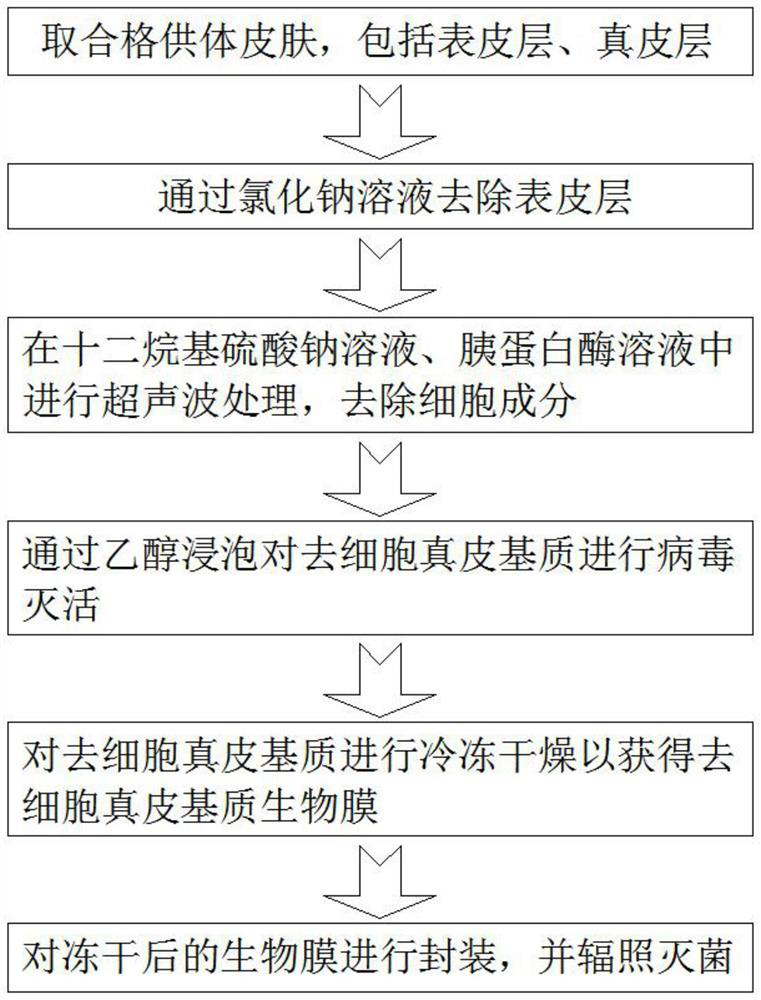Preparation method of biological membrane for dental implantation
A biofilm and dental implant technology, applied in the field of medical biomaterials, can solve problems such as difficulty in ensuring the stability of biofilm, achieve the effect of flexible texture, increase the speed of vascularization, and increase the gap between collagen fibers
- Summary
- Abstract
- Description
- Claims
- Application Information
AI Technical Summary
Problems solved by technology
Method used
Image
Examples
Embodiment 1
[0029] see figure 1 ,
[0030] A method for preparing a biofilm for dental implants, comprising the steps of:
[0031] S1, taking skin: take qualified donor skin as raw material, remove the subcutaneous tissue, and take a certain thickness of sliced skin, including the epidermis and part of the dermis;
[0032] S2, removing the epidermis: after cutting the tomographic skin piece obtained in step S1, put it into a sodium chloride solution for treatment, and remove the epidermis to obtain a dermal matrix;
[0033] S3, Ultrasonic to remove cell components: the dermal matrix obtained in step S2 is subjected to ultrasonic treatment in sodium dodecyl sulfate (SDS) solution and trypsin solution, broken and removed cell components;
[0034] S4, virus inactivation: taking the decellularized dermal matrix treated in step S3, soaking in ethanol for virus inactivation;
[0035] S5, freeze-drying: take the decellularized dermal matrix treated in step S4, and perform freeze-drying to o...
Embodiment 2
[0038] see figure 1 , to further elaborate and supplement Example 1, the step S1 is processed by a drum-type dermatologist or an electric dermatologist, and a 0.3-0.6mm sliced skin is taken, and the strict control of the thickness can ensure the stability of the subsequent steps To obtain qualified biofilm materials.
[0039] The concentration of the sodium chloride solution used in the step S2 is 1-2 mol / L, and the tomographic skin is shaken in the sodium chloride solution at a constant temperature of 30-37° C. for 16-36 hours.
[0040] In step S3, when ultrasonically treating the dermal matrix, first put the dermal matrix into 5-20 g / L sodium dodecyl sulfate (SDS) sterile saline solution, and treat it at room temperature under ultrasonic conditions for 0.5-4 hours , break the cells, and wash and remove the cell debris; thus, the cells can be broken and the cytokine sheets can be cleaned easily;
[0041] Then put it into 1-2.5g / L trypsin sterile saline solution, and wash ...
Embodiment 3
[0051] This application prepares a biofilm derived from human tissue, and introduces ultrasonic technology into the preparation process to completely remove cell components. Trypsin can increase the gap between collagen fibers and increase the speed of vascularization after implantation; using unique freeze-drying technology, The prepared biofilm is flexible and easy to use; it overcomes the immunogenicity derived from heterogeneous materials and the easy degradation of synthetic collagen films, and provides an extracellular matrix biomaterial for dental implants.
PUM
 Login to View More
Login to View More Abstract
Description
Claims
Application Information
 Login to View More
Login to View More - R&D
- Intellectual Property
- Life Sciences
- Materials
- Tech Scout
- Unparalleled Data Quality
- Higher Quality Content
- 60% Fewer Hallucinations
Browse by: Latest US Patents, China's latest patents, Technical Efficacy Thesaurus, Application Domain, Technology Topic, Popular Technical Reports.
© 2025 PatSnap. All rights reserved.Legal|Privacy policy|Modern Slavery Act Transparency Statement|Sitemap|About US| Contact US: help@patsnap.com

